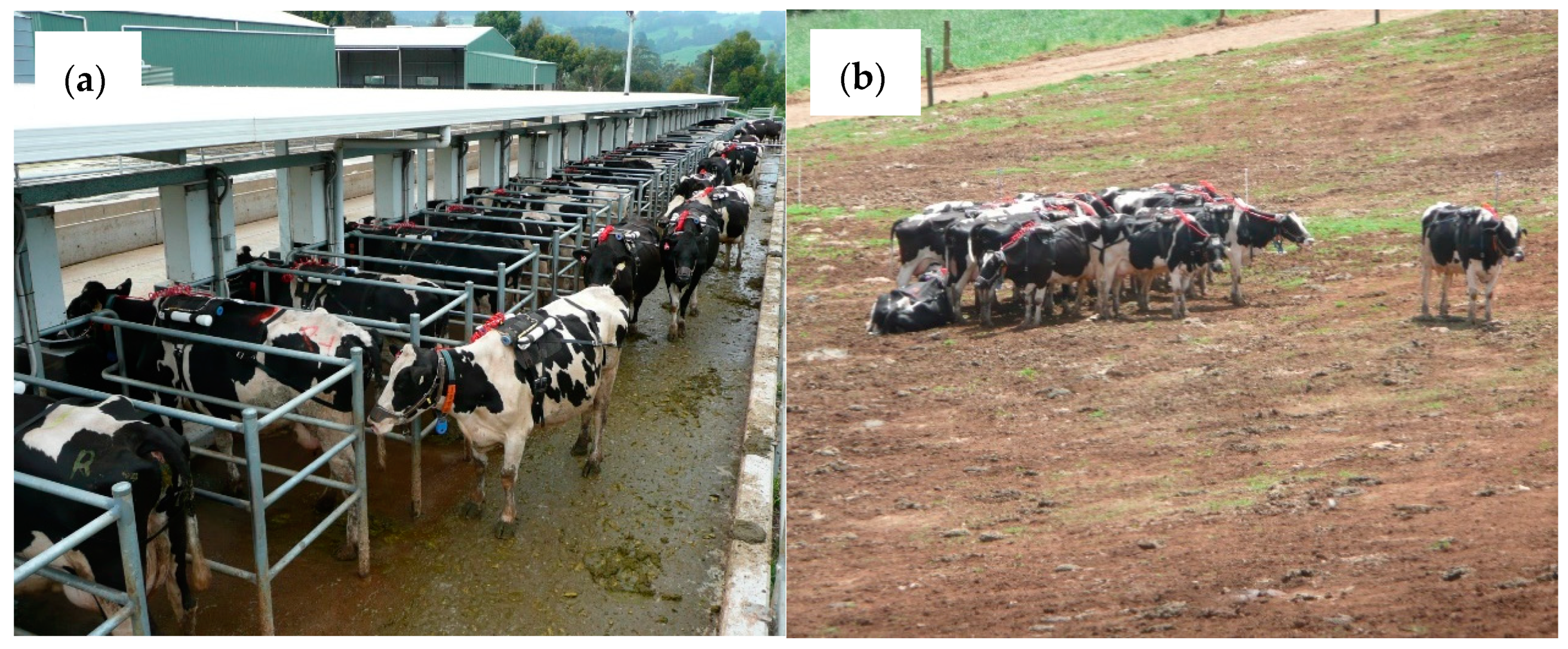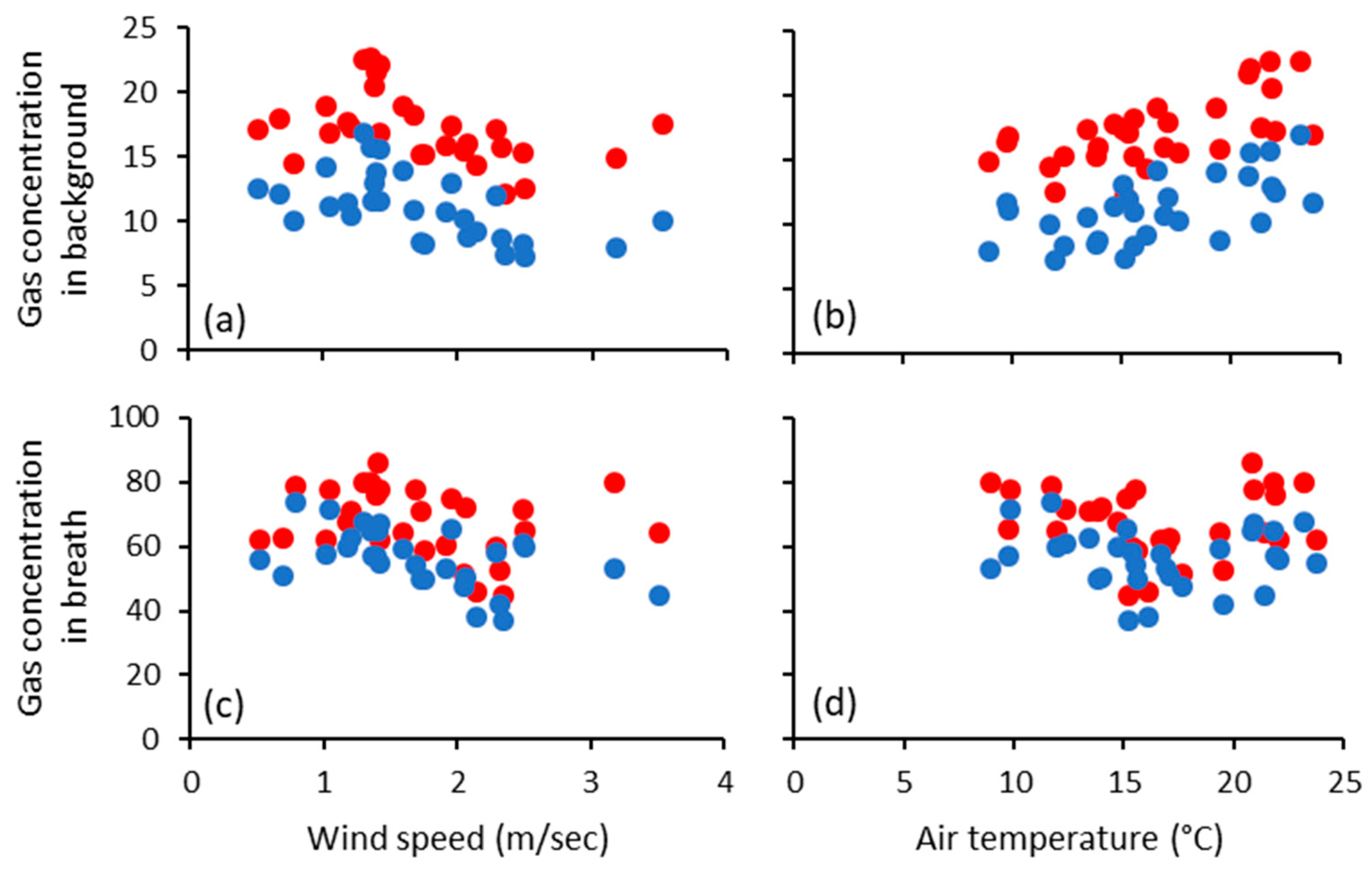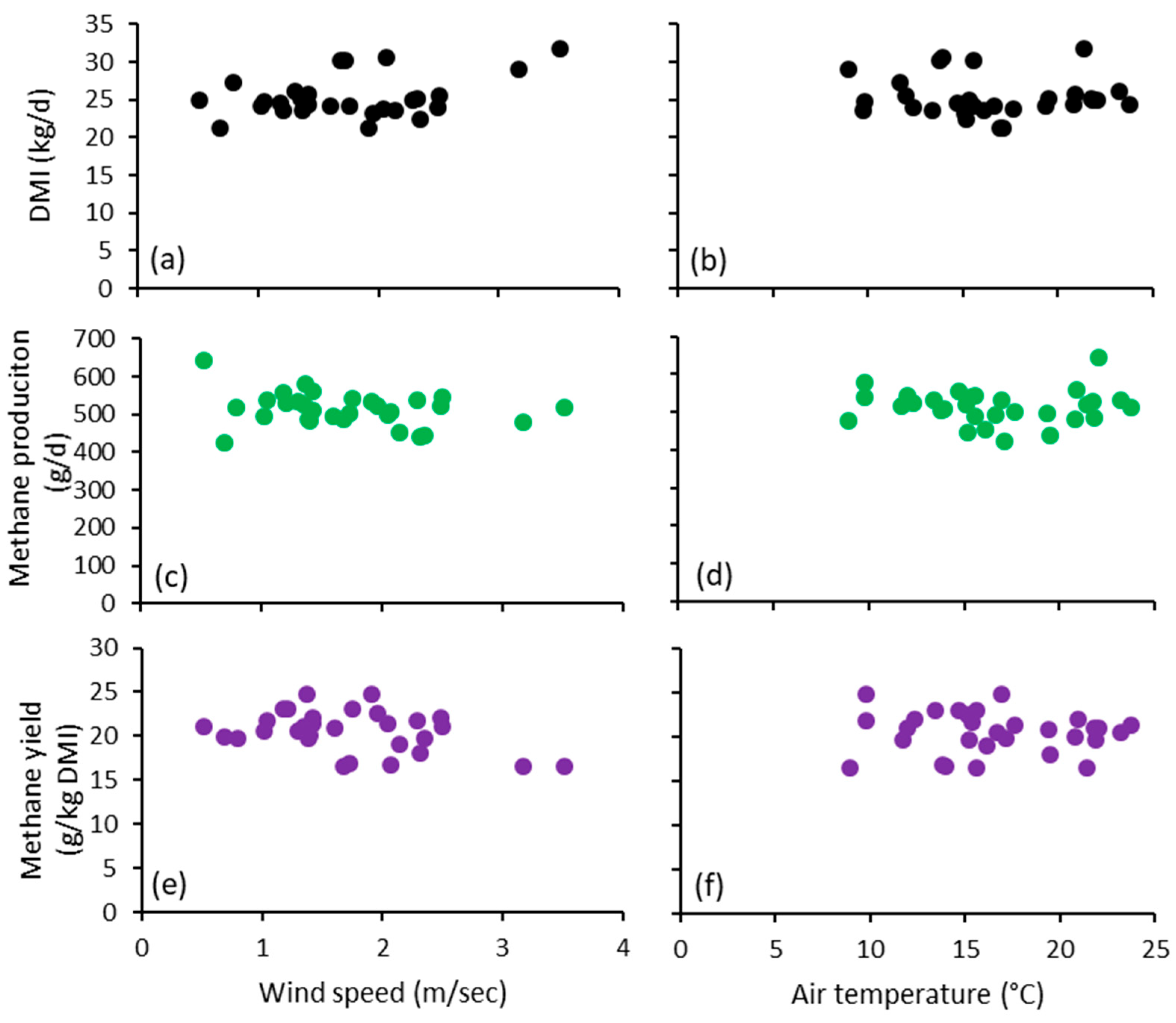Measurement of Enteric Methane Emissions by the SF6 Technique Is Not Affected by Ambient Weather Conditions
Abstract
:Simple Summary
Abstract
1. Introduction
2. Materials and Methods
2.1. Cows and Diet
2.2. Measurement of Methane Production
2.3. Weather Data
2.4. Calculations and Statistics
3. Results
4. Discussion
5. Conclusions
Author Contributions
Funding
Institutional Review Board Statement
Data Availability Statement
Acknowledgments
Conflicts of Interest
References
- Garnsworthy, P.C.; Difford, G.F.; Bell, M.J.; Bayat, A.R.; Huhtanen, P.; Kuhla, B.; Lassen, J.; Peiren, N.; Pszczola, M.; Sorg, D.; et al. Comparison of methods to measure methane for use in genetic evaluation of dairy cattle. Animals 2019, 9, 837. [Google Scholar] [CrossRef] [PubMed] [Green Version]
- Garnsworthy, P.C.; Craigon, J.; Hernandez-Medrano, J.H.; Saunders, N. On-farm methane measurements during milking correlate with total methane production by individual dairy cows. J. Dairy Sci. 2012, 95, 3166–3180. [Google Scholar] [CrossRef] [PubMed] [Green Version]
- Huhtanen, P.; Cabezas-Garcia, E.H.; Utsumi, S.; Zimmerman, S. Comparison of methods to determine methane emissions from dairy cows in farm conditions. J. Dairy Sci. 2015, 98, 3394–3409. [Google Scholar] [CrossRef] [Green Version]
- Zhao, Y.; Nan, X.; Yang, L.; Zheng, S.; Jiang, L.; Xiong, B. A review of enteric methane emission measurement techniques in ruminants. Animals 2020, 10, 1004. [Google Scholar] [CrossRef] [PubMed]
- Hammond, K.J.; Humphries, D.J.; Crompton, L.A.; Green, C.; Reynolds, C.K. Methane emissions from cattle: Estimates from short-term measurements using a GreenFeed system compared with measurements obtained using respiration chambers or sulphur hexafluoride tracer. Anim. Feed Sci. Technol. 2015, 203, 41–52. [Google Scholar] [CrossRef]
- Moate, P.J.; Jacobs, J.L.; Hannah, M.C.; Morris, G.L.; Beauchemin, K.A.; Alvarez Hess, P.S.; Eckard, R.J.; Liu, Z.; Rochfort, S.; Wales, W.J.; et al. Adaptation responses in milk fat yield and methane emissions of dairy cows when wheat was included in their diet for 16 weeks. J. Dairy Sci. 2018, 101, 7117–7132. [Google Scholar] [CrossRef] [PubMed] [Green Version]
- Hammond, K.J.; Crompton, L.A.; Bannink, A.; Dijkstra, J.; Yáñez-Ruiz, D.R.; O’Kiely, P.; Kebreab, E.; Eugène, M.A.; Yu, Z.; Shingfield, K.J.; et al. Review of current in vivo measurement techniques for quantifying enteric methane emission from ruminants. Anim. Feed Sci. Technol. 2016, 219, 13–30. [Google Scholar] [CrossRef] [Green Version]
- Pickering, N.K.; de Haas, Y.; Basarab, J.; Cammack, K.; Hayes, B.J.; Hegarty, R.S.; Lassen, J.; McEwan, J.C.; Miller, S.P.; Pinares-Patiño, C.S.; et al. Consensus Methods for Breeding Low Methane Emitting Animals; A White Paper Prepared by the Animal Selection; Genetics and Genomics Network of the Livestock Research Group of Global Research Alliance for Reducing Greenhouse Gases from Agriculture: Palmerston North, New Zealand, 2013. [Google Scholar]
- Charmley, E.; Williams, S.R.O.; Moate, P.J.; Hegarty, R.S.; Herd, R.M.; Oddy, V.H.; Reyenga, P.; Staunton, K.M.; Anderson, A.; Hannah, M.C. A universal equation to predict methane production of forage-fed cattle in Australia. Anim. Prod. Sci. 2016, 56, 169–180. [Google Scholar] [CrossRef] [Green Version]
- Niu, M.; Kebreab, E.; Hristov, A.N.; Oh, J.; Arndt, C.; Bannink, A.; Bayat, A.R.; Brito, A.F.; Boland, T.; Casper, D.; et al. Prediction of enteric methane production, yield, and intensity in dairy cattle using an intercontinental database. Glob. Chang. Biol. 2018, 24, 3368–3389. [Google Scholar] [CrossRef] [PubMed] [Green Version]
- Madsen, J.; Bjerg, B.S.; Hvelplund, T.; Weisbjerg, M.R.; Lund, P. Methane and carbon dioxide ratio in excreted air for quantification of the methane production from ruminants. Livest. Sci. 2010, 129, 223–227. [Google Scholar] [CrossRef]
- Bougouin, A.; Appuhamy, J.A.D.R.N.; Ferlay, A.; Kebreab, E.; Martin, C.; Moate, P.J.; Benchaar, C.; Lund, P.; Eugène, M. Individual milk fatty acids are potential predictors of enteric methane emissions from dairy cows fed a wide range of diets: Approach by meta-analysis. J. Dairy Sci. 2019, 102, 10616–10631. [Google Scholar] [CrossRef] [PubMed] [Green Version]
- Williams, S.R.O.; Hannah, M.C.; Jacobs, J.L.; Wales, W.J.; Moate, P.J. Volatile fatty acids in ruminal fluid can be used to predict methane yield of dairy cows. Animals 2019, 9, 1006. [Google Scholar] [CrossRef] [Green Version]
- Negussie, E.; de Haas, Y.; Dehareng, F.; Dewhurst, R.J.; Dijkstra, J.; Gengler, N.; Morgavi, D.P.; Soyeurt, H.; van Gastelen, S.; Yan, T.; et al. Invited review: Large-scale indirect measurements for enteric methane emissions in dairy cattle: A review of proxies and their potential for use in management and breeding decisions. J. Dairy Sci. 2017, 100, 2433–2453. [Google Scholar] [CrossRef] [PubMed] [Green Version]
- Zimmerman, P.R. System for Measuring Metabolic Gas Emissions from Animals. U.S. Patent 5265618, 30 November 1993. [Google Scholar]
- Johnson, K.; Huyler, M.; Westberg, H.; Lamb, B.; Zimmerman, P. Measurement of methane emissions from ruminant livestock using a SF6 tracer technique. Environ. Sci. Technol. 1994, 28, 359–362. [Google Scholar] [CrossRef]
- Ulyatt, M.J.; Baker, S.K.; McCrabb, G.J.; Lassey, K.R. Accuracy of SF6 tracer technology and alternatives for field measurements. Aust. J. Agric. Res. 1999, 50, 1329–1334. [Google Scholar] [CrossRef]
- Williams, S.R.O.; Moate, P.J.; Hannah, M.C.; Ribaux, B.E.; Wales, W.J.; Eckard, R.J. Background matters with the SF6 tracer method for estimating enteric methane emissions from dairy cows: A critical review. Anim. Feed Sci. Technol. 2011, 170, 265–276. [Google Scholar] [CrossRef]
- Boadi, D.A.; Wittenberg, K.M. Methane production from dairy and beef heifers fed forages differing in nutrient density using the sulfur hexafluoride (SF6) tracer gas technique. Can. J. Anim. Sci. 2002, 82, 201–206. [Google Scholar] [CrossRef] [Green Version]
- Vlaming, J.B.; Lopez-Villalobos, N.; Brookes, I.M.; Hoskin, S.O.; Clark, H. Within- and between-animal variance in methane emissions in non-lactating dairy cows. Aust. J. Exper. Agric. 2008, 48, 124–127. [Google Scholar] [CrossRef] [Green Version]
- Lassey, K.R. On the importance of background sampling in applications of the SF6 tracer technique to determine ruminant methane emissions. Anim. Feed Sci. Technol. 2013, 180, 115–120. [Google Scholar] [CrossRef]
- Deighton, M.H.; Williams, S.R.O.; Hannah, M.C.; Eckard, R.J.; Boland, T.M.; Wales, W.J.; Moate, P.J. A modified sulphur hexafluoride tracer technique enables accurate determination of enteric methane emissions from ruminants. Anim. Feed Sci. Technol. 2014, 197, 47–63. [Google Scholar] [CrossRef] [Green Version]
- Garner, J.B.; Douglas, M.L.; Williams, S.R.O.; Wales, W.J.; Marett, L.C.; Nguyen, T.T.T.; Reich, C.M.; Hayes, B.J. Genomic selection improves heat tolerance in dairy cattle. Sci. Rep. 2016. [Google Scholar] [CrossRef] [PubMed]
- West, J.W.; Mullinix, B.G.; Bernard, J.K. Effects of Hot, Humid Weather on Milk Temperature, Dry Matter Intake, and Milk Yield of Lactating Dairy Cows. J. Dairy Sci. 2003, 86, 232–242. [Google Scholar] [CrossRef] [Green Version]
- Shelquist, R. An Introduction to Air Density and Density Altitude Calculations. Available online: https://wahiduddin.net/calc/density_altitude.htm (accessed on 19 November 2020).
- Betts, A.K.; Desjardins, R.; Worth, D.; Beckage, B. Climate coupling between temperature, humidity, precipitation, and cloud cover over the Canadian Prairies. J. Geophys. Res. Atmos. 2014, 119, 13305–313326. [Google Scholar] [CrossRef]
- Roche, J.R.; Turner, L.R.; Lee, J.M.; Edmeades, D.C.; Donaghy, D.J.; Macdonald, K.A.; Penno, J.W.; Berry, D.P. Weather, herbage quality and milk production in pastoral systems. 4. Effects on dairy cattle production. Anim. Prod. Sci. 2009, 49, 222–232. [Google Scholar] [CrossRef]
- Dairy One. Analytical Procedures. Available online: https://dairyone.com/download/forage-forage-lab-analytical-procedures/ (accessed on 7 October 2019).
- Atwater, W.O.; Woods, C.D. The Chemical Composition of American Food Materials; US Department of Agriculture, Office of Experiment Stations, Bulletin No. 109; Government Printing Office: Washington, DC, USA, 1896. [Google Scholar]
- Nakagawa, S.; Schielzeth, H. A general and simple method for obtaining R2 from generalized linear mixed-effects models. Methods Ecol. Evol. 2013, 4, 133–142. [Google Scholar] [CrossRef]
- NOAA. National Oceanic & Atmospheric Administration Research. Available online: https://www.esrl.noaa.gov/gmd/hats/combined/SF6.html (accessed on 14 November 2020).
- Hammond, K.J.; Jones, A.K.; Humphries, D.J.; Crompton, L.A.; Reynolds, C.K. Effects of diet forage source and neutral detergent fiber content on milk production of dairy cattle and methane emissions determined using GreenFeed and respiration chamber techniques. J. Dairy Sci. 2016, 99, 7904–7917. [Google Scholar] [CrossRef]
- Eslamizad, M.; Lamp, O.; Derno, M.; Kuhla, B. The control of short-term feed intake by metabolic oxidation in late-pregnant and early lactating dairy cows exposed to high ambient temperatures. Physiol. Behav. 2015, 145, 64–70. [Google Scholar] [CrossRef] [PubMed]
- West, J.W. Effects of Heat-Stress on Production in Dairy Cattle. J. Dairy Sci. 2003, 86, 2131–2144. [Google Scholar] [CrossRef]
- Garner, J.B.; Douglas, M.; Williams, S.R.O.; Wales, W.J.; Marett, L.C.; DiGiacomo, K.; Leury, B.J.; Hayes, B.J. Responses of dairy cows to short-term heat stress in controlled-climate chambers. Anim. Prod. Sci. 2017, 57, 1233–1241. [Google Scholar] [CrossRef]
- Graunke, K.L.; Schuster, T.; Lidfors, L.M. Influence of weather on the behaviour of outdoor-wintered beef cattle in Scandinavia. Livest. Sci. 2011, 136, 247–255. [Google Scholar] [CrossRef]
- Webster, J.R.; Stewart, M.; Rogers, A.R.; Verkerk, G.A. Assessment of welfare from physiological and behavioural responses of New Zealand dairy cows exposed to cold and wet conditions. Anim. Welf. 2008, 17, 19–26. [Google Scholar]
- NOAA. National Oceanic & Atmospheric Administration Research. Available online: https://www.esrl.noaa.gov/gmd/ccgg/trends_ch4/ (accessed on 14 November 2020).
- Vlaming, J.B.; Brookes, I.M.; Hosking, S.O.; Pinares-Patiño, C.S.; Clark, H. The possible influence of intra-ruminal sulphur hexafluoride release rates on calculated methane emissions from cattle. Can. J. Anim. Sci. 2007, 87, 269–275. [Google Scholar] [CrossRef]
- Berndt, A.; Boland, T.M.; Deighton, M.H.; Gere, J.I.; Grainger, C.; Hegarty, R.S.; Iwaasa, A.D.; Koolaard, J.P.; Lassey, K.R.; Luo, D.; et al. Guidelines for Use of Sulphur Hexafluoride (SF6) Tracer Technique to Measure Enteric Methane Emissions from Ruminants; New Zealand Agricultural Greenhouse Gas Research Centre: Palmerston North, New Zealand, 2014; p. 166. [Google Scholar]
- Harper, L.A.; Denmead, O.T.; Flesch, T.K. Micrometeorological techniques for measurement of enteric greenhouse gas emissions. Anim. Feed Sci. Technol. 2011, 166–167, 227–239. [Google Scholar] [CrossRef]
- Zimmerman, P.R.; Zimmerman, R.S. Method and System for Monitoring and Reducing Ruminant Methane Production. U.S. Patent 8307785, 28 June 2011. [Google Scholar]



| Item | 2015 | 2016 | 2017 | Average |
|---|---|---|---|---|
| Dry matter | 863 | 874 | 870 | 869 |
| Crude protein | 190 | 168 | 173 | 177 |
| Soluble protein (% of CP) | 34.2 | 36.1 | 30.3 | 33.5 |
| Acid detergent fiber | 289 | 316 | 316 | 307 |
| Neutral detergent fiber | 357 | 380 | 371 | 369 |
| Lignin | 71 | 72 | 78 | 74 |
| Non-fiber carbohydrate | 338 | 348 | 358 | 348 |
| Starch | 92 | 110 | 124 | 109 |
| Crude fat | 21 | 18 | 21 | 20 |
| Metabolizable energy (MJ/kg, DM) | 10.1 | 9.8 | 10.0 | 10.0 |
| Gross energy (MJ/kg, DM) | 17.7 | 17.1 | 18.2 | 17.7 |
| Ash | 94 | 86 | 77 | 86 |
| Calcium | 11.7 | 10.4 | 12.0 | 11.4 |
| Magnesium | 3.1 | 3.1 | 3.2 | 3.1 |
| Phosphorus | 3.3 | 3.0 | 3.5 | 3.3 |
| Potassium | 25.8 | 25.1 | 16.4 | 22.4 |
| Sodium | 1.1 | 0.6 | 0.7 | 0.8 |
| Iron (ppm) | 212 | 179 | 257 | 216 |
| Zinc (ppm) | 77 | 70 | 63 | 70 |
| Copper (ppm) | 25 | 24 | 21 | 23 |
| Manganese (ppm) | 74 | 70 | 59 | 68 |
| Sulfur | 3.2 | 3.1 | 3.0 | 3.1 |
| Chloride ion | 6.9 | 5.9 | 4.2 | 5.7 |
| DCAD (mEq/100 g, DM) | 32 | 31 | 15 | 26 |
| Item. | Average | Standard Deviation | Minimum | Maximum |
|---|---|---|---|---|
| Average daily wind speed (m/sec) | 1.7 | 0.69 | 0.5 | 3.5 |
| Maximum daily wind speed (m/sec) | 4.9 | 1.80 | 1.6 | 9.3 |
| Minimum daily wind speed (m/sec) | 0.1 | 0.25 | 0.0 | 1.3 |
| Average daily temperature (°C) | 16.5 | 4.19 | 9.0 | 23.8 |
| Maximum daily temperature (°C) | 23.0 | 6.33 | 14.0 | 34.1 |
| Minimum daily temperature (°C) | 10.9 | 3.37 | 3.0 | 16.9 |
| Average daily relative humidity (%) | 79.7 | 11.3 | 51.4 | 97.9 |
| Maximum daily relative humidity (%) | 99.4 | 1.68 | 93.1 | 100.0 |
| Minimum daily relative humidity (%) | 54.0 | 17.0 | 15.2 | 84.8 |
| Total daily rainfall (mm) | 3.0 | 4.99 | 0.0 | 20.0 |
| Equation | R2 | p Values | |||
|---|---|---|---|---|---|
| Wind | Air Temp | Humidity | Rainfall | ||
| BGSF6 = 25.6 ± 4.79 − 1.9 ± 0.40 DW + 0.020 ± 0.091 DT − 0.072 ± 0.040 DH + 0.10 ± 0.046 DR | 0.29 | 0.001 | 0.825 | 0.083 | 0.040 |
| BGCH4 = 23.3 ± 5.21 − 2.3 ± 0.44 DW − 0.04 ± 0.099 DT − 0.10 ± 0.043 DH + 0.16 ± 0.051 DR | 0.21 | 0.001 | 0.667 | 0.030 | 0.004 |
| CBSF6 = 109 ± 19.1 − 5.2 ± 1.57 DW − 1.5 ± 0.36 DT − 0.13 ± 0.16 DH + 0.63 ± 0.18 DR | 0.22 | 0.003 | 0.001 | 0.419 | 0.002 |
| CBCH4 = 97.9 ± 19.87 − 5.3 ± 1.67 DW − 1.39 ± 0.38 DT − 0.14 ± 0.16 DH + 0.59 ± 0.19 DR | 0.29 | 0.004 | 0.001 | 0.399 | 0.006 |
| DMI = 24.3 ± 4.25 + 0.29 ± 0.35 DW − 0.005 ± 0.080 DT + 0.008 ± 0.035 DH − 0.014 ± 0.040 DR | 0.51 | 0.410 | 0.954 | 0.830 | 0.729 |
| MeP = 750 ± 141.3 − 26.6 ± 14.2 DW − 2.6 ± 2.51 DT − 1.8 ± 1.22 DH − 1.3 ± 1.59 DR | 0.14 | 0.072 | 0.312 | 0.155 | 0.408 |
| MeY = 25.8 ± 6.26 − 0.56 ± 0.544 DW − 0.11 ± 0.119 DT − 0.031 ± 0.053 DH − 0.016 ± 0.062 DR | 0.03 | 0.313 | 0.375 | 0.566 | 0.794 |
Publisher’s Note: MDPI stays neutral with regard to jurisdictional claims in published maps and institutional affiliations. |
© 2021 by the authors. Licensee MDPI, Basel, Switzerland. This article is an open access article distributed under the terms and conditions of the Creative Commons Attribution (CC BY) license (http://creativecommons.org/licenses/by/4.0/).
Share and Cite
Moate, P.J.; Pryce, J.E.; Marett, L.C.; Garner, J.B.; Deighton, M.H.; Ribaux, B.E.; Hannah, M.C.; Wales, W.J.; Williams, S.R.O. Measurement of Enteric Methane Emissions by the SF6 Technique Is Not Affected by Ambient Weather Conditions. Animals 2021, 11, 528. https://doi.org/10.3390/ani11020528
Moate PJ, Pryce JE, Marett LC, Garner JB, Deighton MH, Ribaux BE, Hannah MC, Wales WJ, Williams SRO. Measurement of Enteric Methane Emissions by the SF6 Technique Is Not Affected by Ambient Weather Conditions. Animals. 2021; 11(2):528. https://doi.org/10.3390/ani11020528
Chicago/Turabian StyleMoate, Peter J., Jennie E. Pryce, Leah C. Marett, Josie B. Garner, Matthew H. Deighton, Brigid E. Ribaux, Murray C. Hannah, William J. Wales, and S. Richard O. Williams. 2021. "Measurement of Enteric Methane Emissions by the SF6 Technique Is Not Affected by Ambient Weather Conditions" Animals 11, no. 2: 528. https://doi.org/10.3390/ani11020528
APA StyleMoate, P. J., Pryce, J. E., Marett, L. C., Garner, J. B., Deighton, M. H., Ribaux, B. E., Hannah, M. C., Wales, W. J., & Williams, S. R. O. (2021). Measurement of Enteric Methane Emissions by the SF6 Technique Is Not Affected by Ambient Weather Conditions. Animals, 11(2), 528. https://doi.org/10.3390/ani11020528







